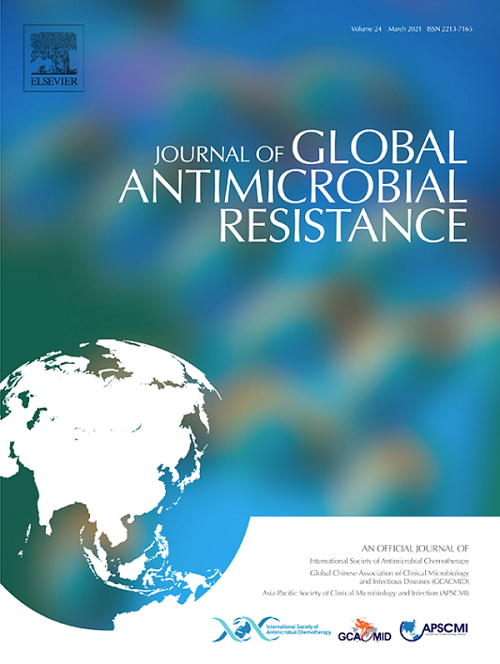Characterisation of blaNDM-5-bearing IncHI2 plasmid from Escherichia fergusonii in China
IF 3.7
3区 医学
Q2 INFECTIOUS DISEASES
引用次数: 0
Abstract
Objective
Carbapenems are considered to be the last resort for serious infections caused by multidrug-resistant Gram-negative bacteria, and the emergence of carbapenem-resistant Enterobacteriaceae has posed a serious threat to human health. However, carbapenem resistance is rarely reported in Escherichia fergusonii. In this study, a New Delhi metallo-β-lactamase (NDM)-5-producing E. fergusonii strain, EFSXRJ10, was isolated from a chicken in China.
Methods
Minimal inhibitory concentrations were determined using broth microdilution-based antimicrobial susceptibility testing. The complete genome sequence of the NDM-positive isolate was obtained using the Illumina NovaSeq and Oxford Nanopore GridION sequencing platforms, followed by hybrid assembly with Unicycler. In the plasmid conjugation assay, a sodium azide–resistant Escherichia coli strain, J53, was employed as the recipient.
Results
Strain EFSXRJ10 was resistant to ampicillin, amoxycillin-clavulanic acid, gentamicin, spectinomycin, tetracycline, florfenicol, sulfafurazole, cefotaxime, ceftazidime, apramycin and meropenem. The blaNDM-5 gene was located on the IncHI2 plasmid, which can be transferred by conjugation at a frequency of (4.78 ± 0.67) × 10–5. The blaNDM-5-carrying plasmid, which harbours 14 antibiotic resistance genes belonging to the IncHI2/ST3 type and exhibiting high similarity to other blaNDM-5-carrying IncHI2 plasmids, was deposited in GenBank. The genetic structure containing blaNDM-5 was organised as ‘IS3000-ΔISAba125-IS5-ΔISAba125-blaNDM-5-bleMBL-trpF-dsbD-IS26-∆umuD-∆ISKox3-∆IS3000’.
Conclusions
This is the first report characterising the blaNDM-5-bearing IncHI2 plasmid in E. fergusonii. Surveillance and control measures should be implemented to halt transmission of blaNDM-5 in food animals.
中国弗格森埃希菌携带blandm -5的IncHI2质粒的特性
目的:碳青霉烯类药物被认为是治疗多重耐药(MDR)革兰氏阴性菌严重感染的最后手段。耐碳青霉烯肠杆菌科的出现对人类健康构成了严重威胁。然而,对碳青霉烯类耐药的报道很少。本研究从中国鸡中分离出一株产NDM-5的弗格森伊杆菌EFSXRJ10。方法:采用微稀释肉汤法测定最小抑菌浓度(mic)。通过Illumina NovaSeq和Oxford Nanopore GridION测序平台获得ndm阳性分离物的全基因组序列,然后与Unicycler杂交组装。在质粒偶联实验中,以抗叠氮化钠的大肠杆菌J53为受体。结果:菌株EFSXRJ10对氨苄西林、阿莫西林-克拉维酸、庆大霉素、大霉素、四环素、氟苯尼考、磺胺呋唑、头孢噻肟、头孢他啶、阿帕霉素、美罗培南耐药。blaNDM-5基因位于IncHI2质粒上。该质粒可以偶联转移,频率为(4.78±0.67) × 10-5。携带blandm -5的质粒含有14个耐药基因,属于IncHI2/ST3型,与GenBank中其他携带blandm -5的IncHI2质粒具有较高的相似性。blaNDM-5周围的遗传结构组织为“IS3000-ΔISAba125-IS5-ΔISAba125-blaNDM-5-bleMBL-trpF-dsbD-IS26-∆umuD-∆ISKox3-∆IS3000”。结论:本文首次报道了弗格森杆菌携带blandm -5的IncHI2质粒的特征。应采取监测和控制措施,阻止blaNDM-5从食用动物传播。
本文章由计算机程序翻译,如有差异,请以英文原文为准。
求助全文
约1分钟内获得全文
求助全文
来源期刊

Journal of global antimicrobial resistance
INFECTIOUS DISEASES-PHARMACOLOGY & PHARMACY
CiteScore
8.70
自引率
2.20%
发文量
285
审稿时长
34 weeks
期刊介绍:
The Journal of Global Antimicrobial Resistance (JGAR) is a quarterly online journal run by an international Editorial Board that focuses on the global spread of antibiotic-resistant microbes.
JGAR is a dedicated journal for all professionals working in research, health care, the environment and animal infection control, aiming to track the resistance threat worldwide and provides a single voice devoted to antimicrobial resistance (AMR).
Featuring peer-reviewed and up to date research articles, reviews, short notes and hot topics JGAR covers the key topics related to antibacterial, antiviral, antifungal and antiparasitic resistance.
 求助内容:
求助内容: 应助结果提醒方式:
应助结果提醒方式:


